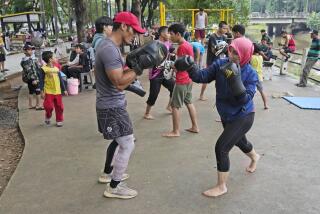A Business Approach to Self-Defense : Martial arts: Machado brothers, who learned jujitsu in Rio de Janiero, have brought their knowledge to Redondo Beach.
With sweat streaming down his face, Chuck Fay got up from the mat after grappling with another student Thursday at the R.C.J. Machado Jiu-Jitsu school in Redondo Beach.
Fay laughed, knowing he had bested his partner, who is more than 30 years younger than the 68-year-old Manhattan Beach resident.
But all 15 students seemed to be enjoying themselves as the five Machado brothers--Carlos, John, Jean Jacques, Rigan and Roger, owners of the school--took turns teaching the martial art of jujitsu, which the brothers have studied since they were young boys in Rio de Janiero.
In 1989, Rigan, 26, met film actor and martial arts expert Chuck Norris while Norris was on a scuba-diving trip in Brazil. They worked out together and Norris, who did not know jujitsu, learned some moves from Rigan. Norris, who has a home in Tarzana, invited Rigan to California to continue the training.
A few months later, Carlos, 29, and John, 23, joined Rigan in Southern California. In a few months the five brothers were living in Redondo Beach.
The Machados started by teaching their style of jujitsu at home to people who heard about them through word of mouth. Norris began to train with them regularly and helped them start a school in Encino in 1991.
“He helped us with his influence,” Carlos said. “His friend was the owner of the mall and he made arrangements that we could initiate the business without paying the high cost. The students we had already made some donations so we could build up the place.
“We had a grand opening with Chuck, so we drew some people. From that point on, it was like a steady growing. More and more people came.”
In December, 1992, the Machados opened their second school, in Redondo Beach.
Norris, who has practiced martial arts for 33 years, said he was intrigued by the Machados’ method of teaching.
“Their style is quite unique,” Norris said. “They’ve got it down to such a fine tuning. Every movement means something, it counts for something. They have some of the best approaches (to teaching) I’ve ever seen. It keeps you motivated, and because of that, their students are very good.”
The Machados are very proud of their association with Norris and speak about him often. Carlos, the actor’s personal trainer, frequently accompanies Norris when he works on location.
“Israel was the last trip we had together,” Carlos said. “I spent three months there. (Norris) trains like two hours daily. The rest of the time I would go with him to the set and I would tour a little bit.”
Jujitsu, a 2,000-year old martial art, was started in India by Buddhist monks. Because of their religious beliefs that weapons could not be used in fighting, the monks designed this style of self-defense to protect their goods from attack. Jujitsu differs from karate because it does not include kicking and striking. It resembles wrestling, with the movements performed on the floor. While many of the students take jujitsu for exercise, Carlos said it is not a sport.
“We address anti-rape techniques for women and also self-defense for senior citizens,” Carlos said. “People come here and they learn effective ways to defend themselves. It works here and it works on the street.”
In Thursday’s beginner class, Jennifer Barrow was the only woman. She said some male friends told her about jujitsu a few months ago. She came to watch a class and decided to join.
“It’s so good for women to learn,” said Barrow, a 20-year-old sophomore at El Camino College. “When a woman is attacked by a man, he wants the woman on her back, and that’s when I can do my best self-defense move. Now I walk with confidence. It makes me feel better, plus I’m getting in shape.”
Carlos recommends women learn jujitsu rather than carrying a weapon.
“If you rely exclusively on guns to defend yourself, many times the guns are unreachable,” Carlos said. “If you’re inside an elevator and a psycho comes in, he’s too close to you. So jujitsu is to fill that gap when the gun can’t help you at all.”
The Machado family has a storied history in jujitsu. John, the youngest brother at 23, says that their great uncle, Carlos Gracie, became the first Brazilian to learn jujitsu in 1917 after being taught by the Japanese.
“He felt a lot of resistance when he introduced jujitsu in Brazil,” John said of his uncle, who is 92. “He was a very skinny guy, but he began to beat the bigger guys. Then he taught his brothers. Once he got very popular in north Brazil, he came down to Rio and Sao Paulo. From ministers to presidents, everybody learned from him.”
Today, more than 100 Southern California students are learning from Gracie’s great-nephews. Each student pays $60 a month for weekly group classes. Weekly semi-private and private lessons cost $120 a month.
“All the brothers are very good instructors,” said student John Van Horst, 30, of Redondo Beach. “When you work with one brother, he tends to emphasize his own technique a little more so you get a different aspect of the training.”
“Jujitsu is almost like therapy,” said Carlos. “People come here to relieve stress. They become more confident. They become more fit. You are practicing something you can count on in a situation of pressure.”
But Fay, who retired last year as a professor of philosophy at Cal State Dominguez Hills, does it for fun.
“I’ve done a lot of exercise,” Fay said. “I’ve swam, it’s boring. I’ve run, it’s boring. When you’re contesting with a body, it’s not boring. There’s no comparison.”


